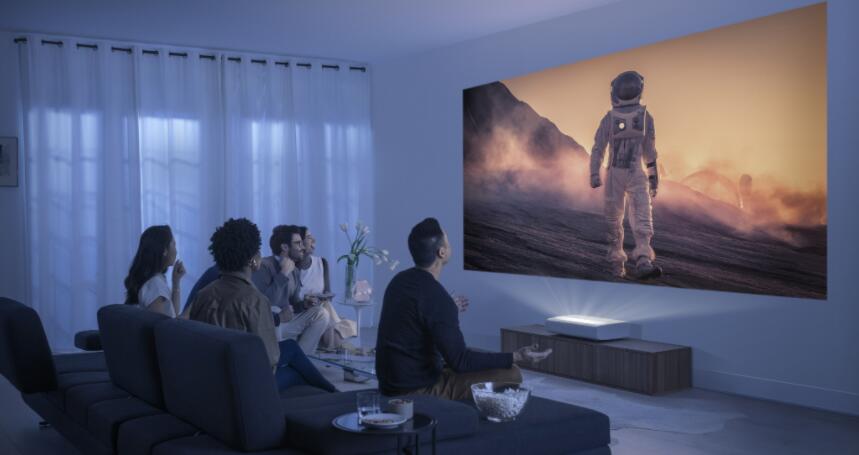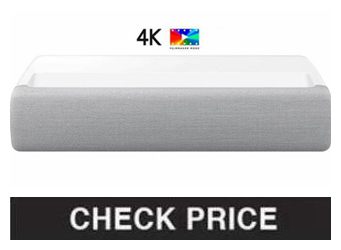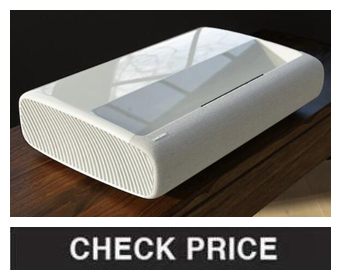
While Samsung is recognized as an industry leader in the flat-panel TV market, they have recently announced the upcoming release of The Premiere – two compact 4K laser projector models that Samsung claims can upgrade your home theater setup so anyone can enjoy a big picture cinema experience from the comfort of their own home.
Over the past few months, we have seen how consumers are spending more time at home and how the role of everyday life continues to change. TV has become the center of entertainment, a fitness partner, a co-worker, and a source for news, said Jongsuk Chu, Executive Vice President of Visual Display Business at Samsung Electronics. The Premiere re-imagines the home cinema experience with an all-new, compact design, 4K picture quality, and big sound for tight spaces that can be used for any at-home activity and living room arrangements.
The Premiere belongs to Samsung’s “Lifestyle” category of home entertainment which includes other ultra-modern, design-centric products like The Serif, The Frame, The Sero, and The Terrace.
Samsung has specifically designed these products to blend beautifully into any décor and the compact, all-in-one, screenless Premiere is the epitome of this design aesthetic. The easy to install Premiere features fabric finishes around its edges intended to complement most environments.
Contents
How To Choose The Best Projector For You
The TV market may have almost entirely emigrated to 4K, but home projection has been slower to follow, though now there are great options.
There are a variety of technologies that can deliver a projected 3840×2160-pixel image. Sony dominates the native 4K space with its SXRD models. These are uniformly large and, shall we say, a touch on the pricey side – but they do look fabulous.
Most cost effective are models that use single chip DLP and 3LCD technologies, which essentially pixel-juggle to deliver a 4K image. The most popular is Texas Instruments DLP UHD solution. While a DLP DMD (Digital Micromirror Device) itself only has 4.15 million mirrors, insanely fast switching coupled with image processing enables it to project an 8 million pixel image. The technique is called XPR (eXpanded Pixel Resolution).
Some enthusiasts argue that as a result XPR projectors aren’t really UHD at all. But the tech gets two thumbs up from us. The image is demonstrably more detailed than that from regular HD projectors. If there is a catch, it’s that the technology doesn’t support a wide colour gamut. It works within a conventional colour space, often referred to as REC.709. But that’s a small, almost imperceptible price to pay considering their value for money.
There’s also been a revolution in illumination technology. While many projectors still use conventional lamps to cast their images, laser light engines and LED are increasingly finding favour. Both tend to run cooler and effectively last for the lifetime of a product, so you won’t be buying a new bulb every couple of years.
Samsung Premiere LSP9T Projector Review:
Samsung is back in the home cinema projector market, after more than a decade away – and its Samsung Premiere flagship beamer is certain to impress.
The Premiere LSP9T’s ultra short throw design, 2800 lumens of laser-driven brightness, support for the latest 4K and HDR picture quality standards, powerful built-in audio system, and built-in tuner and smart system make it a true rival for a king-sized TV – especially as it produces mostly outstanding pictures.
Brightness and color volume are both exceptional for a projector, getting maximum value from an innovative new laser light source design. Here, for once, is a projector that actually handles HDR content well – despite that content being designed for TV rather than projection technologies.
The Premiere LSP9T’s pictures genuinely look 4K too, delivering a dense, cinematic image free of visible image structure even at its 130-inch maximum image size.
- Bright, colorful pictures
- Good in light and dark rooms
- Full TV-style smart system
- Some rainbow effect
- Some iffy presets for dark scenes
- OS can be sluggish
Appearance
As seems to be the current trend with many of these UST projectors, the housing of the unit is only available in white. I understand that Samsung and other manufacturers opt for the white housing for a more modern aesthetic, but I would personally prefer a black housing option to match the other components on or in the credenza.
It features rounded corners and an attractive fabric cover for the speakers on the front of the unit. The projector’s lens is recessed beneath the top of the projector as are most other home theater USTs.
On the back left of the projector is where you will find the power button and other connectivity ports.
This unit has 3 HDMI inputs, 1 of which supports eARC. There is also an optical audio out, usb 5V charging port, network cable, coaxial cable input and Ex-Link Samsung service port.
On the bottom of the projector, there are 2 adjustable feet in the front which will allow you to physically fine tune alignment with your screen.
The Included remote control has your basic volume and channel control as well as buttons to trigger voice commands, and typical playback and menu options.
Sound
If you are spending $6,500 on a projector such as this, I would likely suspect or strongly suggest you are also going to be utilizing a separate, dedicated sound system.
Regardless of how good an integrated soundbar is with a projector, having all of your audio come from an area the size of only a center channel significantly reduces the overall sound stage and cinematic experience.
That being said, the integrated audio on the LSP9T is pretty darn good.
The LSP9T has a 4.2 channel, 40w sound system with built in tweeters, woofers and acoustic beam up-firing speakers. The audio is rather crisp and dialogue form any content we previewed was clear.
The speakers were adequate for television viewing however as expected, the lack of a dedicated subwoofer leaves a rather anemic sound when looking for that cinematic experience.
Setup
Setup can be rather tedious with all UST projectors as they lack features common in traditional throw projectors such as lens shift and zoom. This means that proper image positioning and alignment with screen is primarily handled by physically adjusting the projector.
As with all UST projectors, even the slightest movement of the projector will significantly impact the placement and geometry of the image. UST projectors also really require a flat, level surface to projector onto (such as a projector screen) in order to prevent any distortion.
The LSP9T has a couple of geometric correction options to help you get the image just right. The most simplistic is a 4-point correction which allows you to adjust the corners of the screen while the more advanced 15 point correction provides you more granular control of the correction points on the screen.
Overall, I found it relatively painless to get this projector dialed into our 120” screen by using the 15 point correction but your mileage may vary.
This projector also has a safety feature that dims the image when it senses something in the path of the light to prevent damage to the eyes caused by the laser light source.
The interface on this unit is the same experience you would get with a current generation Samsung smart tv. While I have no experience with one of those, I still found this interface very intuitive and appreciated the inclusion of built in streaming apps which all support 4k streaming. Flipping through various picture modes and fine tuning the image were pretty straight forward and I don’t anticipate people having much trouble with this.
Image
One of the key differentiation factors of the LSP9T compared to any other 4k UST currently available is the triple laser light source, which used independent Red, Green and Blue lasers which produces some of the most stunning and vivid colors that I have seen from any projector.
This projector covers around 147% of the DC P3 color spectrum and around 106% of BT2020 and will have you future proofed as content taking advantage of that wide color gamut becomes increasingly more available. This is the first projector that is HDR10+ certified and will provide a superior high dynamic range experience.
The specifications of this unit detail a 2,000,000 : 1 dynamic contrast ratio which utilizes the projector’s Dynamic Black for a perceived contrast far superior to it’s lower priced UST alternatives.
Samsung LSP7T Projector
LSP7T is the smallest in the new Premiere series. It can project an image of up to 120 inches on the wall in front – then at a distance of 30 cm. As you place the projector closer to the wall, the image also becomes smaller. If you place it close to the wall, the picture will be about 80 inches. With a price of GBP 3.999, it is not too far away from the most popular flat screens in the 75-85-inch class. So maybe this is an interesting alternative to a new big screen?
- The LSP7T provides a large and razor-sharp image with enough brightness to work fine in a (dimmed) living room
- The Samsung projector can be a bit of a hassle to set up and set up – we miss a motorised lens
Design
The Samsung projectors in the Premiere series both have a sleek and interior-friendly appearance. The LSP7T is the more compact of the two, with a cabinet in glossy white plastic, and light gray fabric over the speakers on the front. The connections are hidden on the back, together with the on/off button. We think it could have been on the front, but Samsung probably thinks that we rather use the remote control in daily life.
The Samsung projector stands on three rubber feet, where the two rear ones are used to fine-tune the angle of the projector.
The projector lens is mounted on top, and beams the image onto the wall. The LSP7T is also equipped with a motion sensor that dims the brightness when something or someone comes close to the lens. You do not want to look into the projector light – then you must expect to be temporarily blinded!
Ease of use and features
Many people will probably notice the remote control: it is about exactly the same as the one we find on Samsung’s smart TVs. The same applies to the menu system, which contains many of the features we know from the TV world. Streaming services such as YouTube, Netflix and Disney+ are available directly from the the projector. You can also share content from the mobile screen via Wi-Fi or AirPlay 2.
For those of us who are well acquainted with Samsung’s TV models, it is easy to become familiar with the operation of the LSP7T. The projector starts quickly and lights up the wall in front of us in a few seconds – significantly faster than traditional projectors. There is also no annoying fan noise.
Setup
Before you can use the projector, however, you have to expect some adjustment.
It’s not enough to just slam the projector down on the TV bench and hope for a brilliant big picture!
The Samsung projector projects the image at a very steep angle onto the wall or screen. You must therefore be extra careful with the positioning to avoid the image being skewed or out of focus.
Although Samsung has included some digital adjustment options (including keystone), these are best suited for fine-tuning after you have finished the physical location.
For our part, we spent a good deal of time before we were satisfied with the geometry and sharpness of the image. At the same time, it struck us that many (especially families with children) will probably prefer to mount the projector in the ceiling: A very small “oops!” means that the projector must be readjusted.
Image quality
After we made the image fit within the framework of a 110″ canvas, we were finally able to concentrate on the image experience in practice. And it’s not that bad at all.
The first impression is that there is plenty of light here: the Samsung projector does not need to be in a darkened room to provide a usable picture experience – it keeps turning off the light and / or pulling the windows during the day. But as with most projectors, you obviously get better contrast when it’s really dark.
Then we let ourselves be impressed by the sharpness. On a daily basis, we test many 4K TVs of 55-65 inches – but it is really something completely different to see the same pictures blown up to 110 “!
Since the Samsung project has direct access to YouTube and Netflix, there is plenty of content to frolic in. Here we can take in the small details, without seeing the slightest hint of pixel structure or grid pattern. We found some gorgeous clips from Eugene Belsky on YouTube, and at their best it looks really magical.
Sound quality
Samsung has equipped the LSP7T with built-in speakers and 30 watts of output power. The sound is roughly equivalent to what you would expect from a regular TV. The Samsung speaker creates a fairly large and clear sound image, with good voice reproduction and usable fullness in the bass. They have also managed to raise the sound image a bit, so that the voices come from a point in the middle of the image, and not directly from the speakers.
We say we are quite happy with the sound, but we still think most people who consider a projector in this price range, will prefer a separate, more powerful sound layout. With HDMI ARC audio output on the back, it is fortunately easy to connect a potent audio board if desired.

